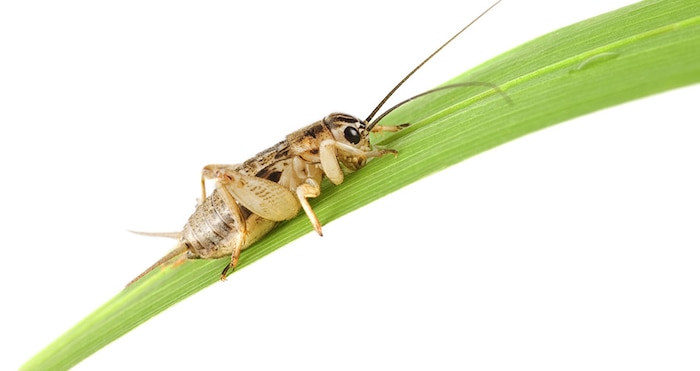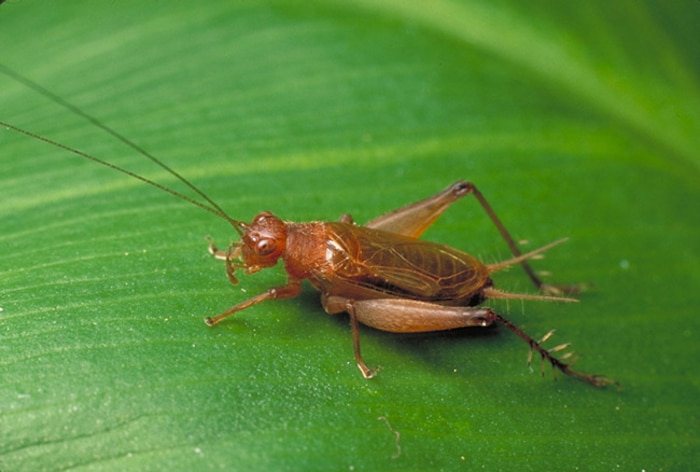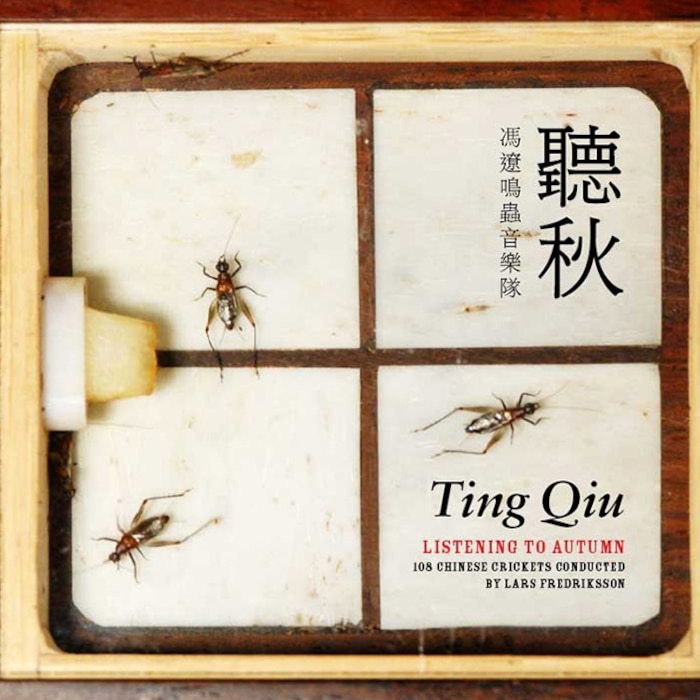Mr. Fung’s Cricket Orchestra
David Rothenberg has been writing about the music that animals make for more than a decade. A musician and philosopher, his latest book is Bug Music: How Insects Gave Us Rhythm and Noise. In this edited and condensed excerpt, Rothenberg describes his visit with a man known as Mr. Fung, a cricket enthusiast from Sweden, who has devoted a great deal of his life to exploring the insect’s songs.

On the Södermalm of Stockholm, the biggest island in a city of islands, I’m climbing up a steep street with a man who goes by many names. Some call him Bolingo, others know him as Mr. Fung. He looks like a Chinese holy man from a whole different era, wrapped in loose clothes, walking barefoot, a Fu Manchu beard and a shaved head.
“I must say, it always helps to have live crickets on your person.”
But what about those bright blue eyes? They say his real name is Lars Fredriksson, and he may know more about the ancient Chinese custom of raising crickets for singing than anyone in the western world. He too has my same problem of how to get people interested in these tiny insects’ songs. As we amble down the street, he pulls a small, ornately carved wooden box from the folds of his tunic, and slides open a small trap door. “I must say, it always helps to have live crickets on your person.”
Chirp
My eyes widen. “You always carry one around?”
Chirp chirp chirp
Mr. Fung smiles. “I will probably burn in cricket hell for the bad karma of keeping insects in small boxes, but if you want to talk about the environment and how important insects are for the planet, it is a good idea to keep one at the ready. Because they will start the conversation; you don’t have to. A chirping is heard. And then, maybe you pull out a box on the table, and everybody goes ‘What do you have there?’ And then it starts. You didn’t start it, the singing cricket started it. You answer slowly, questions will become multiple, abundant. The problem is that some will go, ‘Oh no you have insects, ahh!’ and some other will go ‘Oh… insects.’ Very different reactions. But then of course, ‘Why do you have insects?’ And my answer is that I prefer the sound of a cricket to that of a bird.”

“Now, why do you like cricket sounds better than birds?” I ask him.
“The sounds I like most are those that put me at ease. It’s the same for crickets. Crickets in nature do not sing unless they feel safe. When there is a thunderstorm, or there is low pressure, or there is some bad weather coming, they will not sing. But on the blades of grass that are dried by the sun, you may see a cricket climbing up, announcing that the coast is clear; you can all go on with your lives – and fornicate.”
The music of insects has always had a close connection to sex and violence. In fact, many more people in China raise and sell crickets for the practice of fighting with them rather than to simply enjoy their sounds. Perhaps the more contemplative among us prefer the songs of crickets to watching them ready themselves for battle. Or maybe not – the rules of the contest are also noble and deep, as Jia Sidao wrote in The Book of Crickets in 1348. These insects too are possessed with five solid virtues that only nature can ensure:
The First Virtue: When it is time to sing, he will sing.
This is trustworthiness.
The Second Virture: On meeting an enemy, he will not hesitate to fight.
This is courage.
The Third Virtue: Even seriously wounded, he will not surrender.
This is loyalty.
The Fourth Virtue: When defeated, he will not sing.
He knows shame.
The Fifth Virtue: When he becomes cold, he will return to his home.
He is wise, and knows the situation.
I mention this to Mr. Fung, and he smiles, knowing that humans have long favored war over music – at least in our actions. Yet loving the cricket song is easier, once you learn to attend to it. More virtues are required, but from within us, not in the rules of the bug.

“There is a reason we have two camps, at least two camps in China, for appreciation of crickets. Youth likes an adrenaline kick, they are excited when you put two contestants against each other and the challenger has an opponent. There are no less than seven weight classes in crickets for fighting. There are high-tech electronic scales produced only for fighting crickets. It is kind of odd when you see some of the very tattooed, young Mafioso who are in charge of the betting of the cricket fights, pulling out these extremely modern gadgets in this very old tradition. There are auctions in Shandong beginning around end of August into early September, where male cricket warriors are sold at prices up to 2,000 dollars.”
“Why would you buy so expensive a cricket? What would you do with him?”
“There are more than 250 different names for bites and hits – we have ‘uppercut,’ they have ‘jaw bite to second bone.’”
“Earn a lot of money gambling. When you put this cricket against some other soldier, the stakes are very, very high. The crickets fight unto death. There are more than 250 different names for bites and hits – we have ‘uppercut,’ they have ‘jaw bite to second bone.’ So many different ways to describe how they attack.” The fighting champions themselves have colorful titles. Purple Headed Golden Wing, Bronze Head and Iron Back, Yin Yang Wing, Strong Man That Nobody Can Harm. You irritate the cricket before the fight, you poke them with a small brush, resembling his antennae. Work them up in a frenzy, collect the bets, and toss them into the ring.
There is also a smaller, more sensitive audience who would rather just listen to the music of these creatures. Fung explains why: “You have gentle people of age that turn mellow, maybe after a sour life that didn’t always serve them well. You have the composers, the opera singers, you have your occasional calligrapher, or painter. They all appreciate the crickets as scholarly playthings. Bring them inside and they are like hostages of nature – close your eyes, you are outdoors.”

Crickets sing long into the autumn as the days and nights turn cold. After some months they tend to enter our houses of their own accord. It happens all over the world, but somehow in China their presence is taken with the greatest seriousness. Think of the end of Bertolucci’s epic film where the emperor, now a humble old man sweeping the steps of the Forbidden City, brings out an aged cricket in a cage to show a small child. The fighting cricket is the sage of order and strength, the singing cricket the sage of the autumn season and the noble acceptance of impending death, the necessary march of time.
But Fung doesn’t see this as giving up. He loves the pull of that lonely sound, and endlessly wonders at how – for hundreds of years – the Chinese have been able to pay such attention to the smallest details of the lives of insects with great meticulousness, “There is another ancient cricket manual from the 11th century that explains how to take care of your aging crickets by boiling pig’s liver, mixing it up with very fine chestnut, and yolk of egg, and a little bit of corn starch. The cricket toward the end is no longer able to feed itself, it says. This is so beautiful – you can stroke him a little bit on the beak, and he will sip a tiny bit a liquid during his final days.” We keep the song alive as long as we can.
The closer the insects come toward death, the more beautiful their songs appear to us.
In the late autumn days outside my own home, when the mornings threaten frost, I am amazed to still hear a few crickets singing. Their pitch is lower, now that it’s become so cold. I can hear each perfect note, a solid rhythm of the tones. It’s like the slowed-down bird songs I’ve created on my computer, revealing ultrasonic structures just beyond the range of human ears. As winter approaches, the crickets themselves have slow-moed their songs so that we humans can better hear them. The closer the insects come toward death, the more beautiful their songs appear to us.
In the garden of the Natural History Museum in Stockholm, Mr. Fung tells me that those individuals with the lowest pitched songs are often the biggest, and the strongest, those that command the highest prices. He also told me that it was possible to artificially lower the pitch of some cricket songs by tapping tiny drops of resin onto their stridulating rear legs and wing. As we slow sounds down by machine, they did so with the sticky liquid from pines. Anything goes in the pursuit of the deepest cricket sound.
Lars Fredriksson worked for years as a librarian in Sweden’s finest Asiatic book collection. After that facility closed down, he got a job at a literary publishing house, seeking out Asian works to render into Swedish. As Lars Fredriksson, he organized documents from the East with his fluent knowledge of the language. As Mr. Fung, he has become as Chinese as he can, delving deep into the curious pursuit of insect music.
But Fung has taken his own radical turn, tried something no Chinese traditionalist would do. He has raised an orchestra of singing crickets, 108 individuals to be exact, the number of Buddhist sutras, the number a devout meditator is supposed to count on his rosary beads as he repeats whatever mantra has been chosen for him; a symbolic number, and a resonant number.
“I felt like an elephant in a porcelain store. However low I kept the volume or however long I paused, I was still playing too much too often.”
Over the years Fung has arranged a series of celebrated concerts of his cricket orchestra together with noted improvising musicians. Adam Rudolph remembers what it was like to play with this insect ensemble. “I loved it, I found it inspiring and soothing at the same time. Their choir sounded complete to me, so it was a matter of tuning in to the timbres I was hearing, and also the rhythms. They would come in and out of sync at certain times, so it was a matter of doing some deep listening to hear where that was. As I would hear certain rhythms pop out, I would play spacious little accents to further bring those existing rhythms out… like making an outline in pen upon something already in pencil.” Drummer Bengt Berger said, “I felt like an elephant in a porcelain store. However low I kept the volume or however long I paused, I was still playing too much too often. Apart from that it was wonderful.”

Fredriksson has released two albums of his cricket orchestra, Tingqiuxuan Presents… and Listening to Autumn. These only feature the insect singers, not the blend with live humans. They are slight bends upon natural possibilities, each species named by the cricket-keepers as if it were a musical instrument: a Heavenly Bell solo upon Bamboo Bell chorus; Small Yellow Bell meets Longevity Bell; Red-legged Ant Bell meets Precious Pagoda Bell. The names are codes to the sound of the music.
“Those stupid Americans, they have even better crickets than we do, and they don’t appreciate them?!”
Does it sound any better than the wild cricket nights of late August and September in America, in the fields, in backyards, in everyday suburbia? In Sweden there are but two singing species, the sonic insect palette is not so wide. But where I live in Northeast America, we have nine months of cricket richness to enjoy, more than in China, with hundreds of species making sounds.
“A few years ago I was standing in line at a cricket shop in Beijing,” says Fung. “I had an iPod with American cricket sounds and I put the headphones on the ears of the man standing behind me, and he was like ‘Wow!’ It was as if he was digging a concert. He took them off and said ‘So are there a lot of people in the States who appreciate cricket songs?’ and I said ‘No.’ And he got so upset that he pulled away, ‘Those stupid Americans, they have even better crickets than we do, and they don’t appreciate them?!’”
H.A. Allard, the pioneer naturalist, agreed with this sentiment way back in 1929. “We Americans are too busy, too hurried, too mechanized in our moods, to hear what this cricket or that katydid says… We are a hurried, worried people.” Allard, who even has a species of ground cricket named after him, surmised that the sound of crickets wasn’t just some rote communication necessary to the evolved process of mating, but a primitive musical sense. “The proclivity for sound-making by one method or another is a ubiquitous impulse and mood of life. The great insect kingdom has not been backward in following the same weird organic trend toward the egotisms of self-expression.”
Ego? In bugs, members of a great swarm? What could Allard be talking about? Well, he explains, think of a human who sings all the time, refusing to shut up. We call such a person the most self-aggrandizing egotist in the room. “If crickets were judged on this basis, they would be the most egotistical creatures on earth, obsessed as no other with the sounds of their own wings.” He admits honestly that we cannot be certain what the meaning of such sound can be for the insects from within. Maybe noisy self-expression is their prime directive or purpose in life. Maybe they’re all after some resounding form of companionship. Or maybe cricket singing “is the elemental impulse of pure art, the love of sound, tone, rhythm of music in some manifestation.”
“What is it all about? Sex alone does not explain it. No cricket needs to chirp himself to death.” H.A. Allard
Allard is not at all satisfied with the idea of sex as the explanation. He takes in the beautiful, high, luminous tone of the snowy tree cricket, sylphlike and nearly impossible to see, and he calculates the sheer weight of all that song. “I have heard the snowy tree cricket chirp at the rate of about 90 times per minute all night long. Think what that means; 5,400 chirps per hour, 64,800 chirps in a 12 hour night, nearly four million chirps in 90 days, demanding the muscular energy of 16 million wing strokes on the basis of four strokes for each chirp…. What is it all about? Sex alone does not explain it. No cricket needs to chirp himself to death.”
Indeed, crickets sing in many human languages. Is this because we know the males are doing it to get attention from the females, or because we know that only beautiful music has a reason to be repeated so endlessly?

